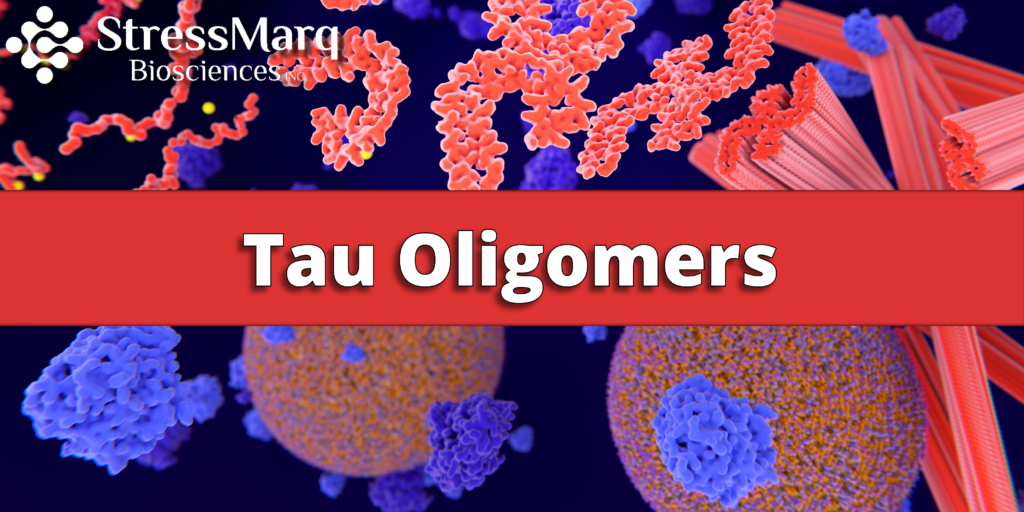Tau Oligomers in Alzheimer’s Disease
Misfolding and aggregation of the microtubule-associated protein tau into neurofibrillary tangles (NFTs) is a pathological hallmark of Alzheimer’s disease and other tauopathies. However, while NFTs have long been considered the main cause of neuronal cell death associated with these disorders, it is now thought that intermediate species of tau are more likely to blame. Understanding the pathological role of pre-fibrillar tau oligomers is critical to determine their potential for therapeutic targeting.
The tau oligomerization pathway
Tau is expressed as six different isoforms, ranging from 352 – 441 amino acids in length, which result from alternative splicing of the MAPT gene1. These are found mainly in neuronal axons, where they function to regulate microtubule assembly and stability. Each tau isoform contains a minimum of 30 distinct phosphorylation sites that, under normal conditions, are in the dephosphorylated state2. Yet, during the development of tauopathies such as Alzheimer’s disease, tau becomes hyperphosphorylated and undergoes conformational changes, leading to its dimerization and self-assembly into larger oligomeric aggregates3. These ultimately associate to form NFTs, which have been widely studied for their role in neurodegenerative disease pathology.
What is the neurotoxic species in tauopathies?
For many years, NFTs were considered to be the main toxic species responsible for neuronal cell death observed in tauopathies. However, more recent studies have suggested this not to be the case4. These include the finding that caspase activation (an irreversible commitment to apoptosis) precedes NFT formation in tau transgenic mice as well as the discovery that NFT-bearing neurons are able to survive despite having compromised membrane integrity5,6. Now, there is a growing body of evidence to indicate that tau oligomers are the most toxic species in disease and may also be responsible for the spread of pathology7. For example, following the sonication of tau fibrils to form tau oligomers (identifiable by Western blotting using an oligomer-specific antibody, T22) and subsequent incubation with SH‐SY5Y neuroblastoma cells, tau oligomers were found to be the toxic species and were more potent in seeding compared to mature fibrils8.
Tau oligomers and Alzheimer’s disease
Although the pathological role of tau oligomers in Alzheimer’s disease remains unclear, it appears increasingly likely that these soluble tau species are the most deleterious form of the protein. Research has revealed tau oligomers to be characterized by the neurotoxicity, infectivity, and capacity for amplification that underlie disease progression, and it has been hypothesized that mitochondrial dysfunction caused by internalized tau oligomers may be fundamental9. Notably, elevated levels of tau oligomers may represent an important early biomarker for Alzheimer’s disease, with utility prior to the appearance of clinical symptoms10.
Targeting oligomeric forms of tau
Because tau oligomers result from hyperphosphorylation, inhibiting the kinases involved in this process is one potential approach to therapeutic intervention. Another strategy is to block tau monomers from interacting, thereby preventing oligomer formation and seeding. In the study previously described, pre-incubating tau oligomers with excess amounts of oligomer-specific T22 antibody was shown to significantly reduce cellular toxicities in vitro, thereby demonstrating the therapeutic value of targeting oligomeric forms of tau8.
Reagents for the study of tau and its role in Alzheimer’s disease
StressMarq has developed a broad range of products for studying tau and its role in Alzheimer’s disease. These include high-quality tau proteins and antibodies, such as our active tau preformed fibrils (PFFs) and filaments that can be used for seeding tau aggregation and induce pathology. The scientific team at StressMarq is currently developing tau oligomers for research use. If you’d like to be alerted when our tau oligomers are available, please sign-up for our e-newsletter.
References
- Tau‑mediated Neurodegeneration and Potential Implications in Diagnosis and Treatment of Alzheimer’s Disease, Wu XL et al, Chin Med J (Engl). 2017 Dec 20;130(24):2978-2990
- Identification of oligomers at early stages of tau aggregation in Alzheimer’s disease, Lasagna-Reeves CA et al, FASEB J. 2012 May;26(5):1946-59
- Characterization of Prefibrillar Tau Oligomers in Vitro and in Alzheimer Disease, Patterson KR et al, J Biol Chem. 2011 Jul 1;286(26):23063-76
- Soluble forms of tau are toxic in Alzheimer’s disease, Koepeikina KJ et al. Transl Neurosci. 2012 Sep;3(3):223-233
- Caspase activation precedes and leads to tangles, de Calignon A et al, Nature. 2010 Apr 22;464(7292):1201-4
- Tangle-bearing neurons survive despite disruption of membrane integrity in a mouse model of tauopathy, de Calignon A et al, J Neuropathol Exp Neurol. 2009 Jul;68(7):757-61
- Advances in therapeutics for neurodegenerative tauopathies: moving toward the specific targeting of the most toxic tau species, Gerson JE et al, ACS Chem Neurosci. 2014 Sep 17;5(9):752-69
- Soluble tau aggregates, not large fibrils, are the toxic species that display seeding and cross‐seeding behavior, Ghag G et al, Protein Sci. 2018 Nov; 27(11): 1901–1909
- Tau Oligomers: Cytotoxicity, Propagation, and Mitochondrial Damage, Shafiei SS et al. Front Aging Neurosci. 2017 Apr 4;9:83
- The Role of Protein Misfolding and Tau Oligomers (TauOs) in Alzheimer’s Disease (AD), Mroczko B et al, Int J Mol Sci. 2019 Sep 20;20(19):4661


Leave a Reply